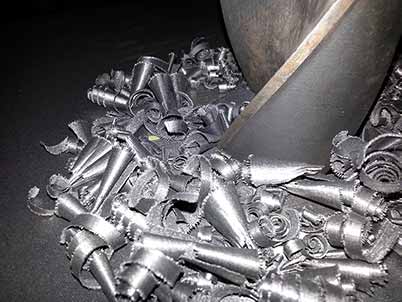
Chip control issues often lead to shortened tool life, conveyor stoppages, poor surface finishes, and increase safety hazards—greatly reducing production time. However, there are ways to recognize these issues before they occur by paying attention to the appearance of the metal chips produced.
Metal chips created during the machining process are often a great indicator of overall process conditions. The appearance of the chips can provide operators with a second line of sight when the windows to the work zone are obscured by scratches, cutting fluid, or tool turrets. Things to look for include chip color, shape, size, and surface finish.
In most machining processes, excess heat is generated. This heat escapes through the environment, the workpiece, the cutting tool, and the metal chip. For instance: Using the optimum cutting speed with steel during dry machining will result in about 75% of the heat-transmitting to the chip, 10% to the material, and 15% to the cutting edge.
A blue-violet color in ISO P group steel will typically tell you that the cutting speed making most of the heat transfer to the chip. With materials that have low heat exchange rates, a large difference in color may mean that the speed is set too high.

There is no right or wrong answer when it comes to the chip’s size. However, the industry-accepted shapes are 6’s and 9’s. These shapes typically indicate that the chip is breaking under its own momentum on the part or other areas that don’t result in damage to the part surface or cutting edges. They are also favored because it means that the chips are not too tight. Extremely high pressure and extra heat are generated if the chips are too tight.

Small chips are almost always better; however, there is really no correct size of chips. That said, the chip should fit correctly into the slot, tool flutes, groove, or bore. This is especially important when dealing with small part boring. Also, small chips can greatly influence floor space. With smaller chips work areas could be moved closer together with smaller bins and more space could be made available for adding additional equipment for production. Also, the size of your chips will determine how much time is dedicated to removal and recycling. If the chips are larger and come off the machine in stringy wads, in-house chip processing equipment can be installed to create shovel-grade chips which can greatly reduce volume up to 25%—saving floor space and time.

A good indicator of the cutting process’s dynamic properties can be seen by looking at the surface finish. A stressed appearance will show in this area if excessively high forces are applied. The chips should also be examined every time a new job, material, or process is being run. Chips that have ragged or serrated edges typically indicate an unstable process.
